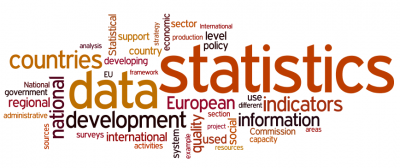Statistics in development cooperation - introduction
This article is part of a set of background articles providing an outline of knowledge of international statistical cooperation between the European Union (EU) and developing countries, for non-statisticians needing to deal with statistics in development programmes and projects. The outline serves as an entry point and introduction to the much more detailed Eurostat publication 'Guide to statistics in European Commission development cooperation', downloadable in PDF format in English, French and Spanish (further down referred to as 'the Guide').
Many developing countries have weak statistical systems and mechanisms for measuring results. Good, reliable statistics are essential for measuring progress in reaching development goals and provide essential information about the effectiveness of policies and programmes. They help governments improve their policies and to be transparent and accountable about the delivery of development results. Reliable statistics are a key element towards better measurement, monitoring and management of the results of development assistance.
Full article
Why the Guide?
If you think that statistics are important but bread is more urgent...
please ask yourself on what information you base your answers to these questions:
- How much bread?
- Where is it needed?
| In order to manage the development process, it is essential to measure it. |
While statistics may not directly reduce poverty or hunger, they are an essential component of a complex process; without adequate statistical data it is by no means certain that actions to reduce poverty:
- will be directed at the right problem;
- will be effective;
- will result in sustained improvements.
Who is the Guide for?
| Eurostat, the statistical office of the European Union, elaborates the Guide for European Commission staff working in development cooperation. |
In particular, the Guide is developed for agents who know very little about statistics and would prefer to spend their time on their core tasks.
The Guide provides them with the required information to:
- use statistical indicators to design and monitor development programmes;
- identify and develop statistics support actions;
- advocate timely consideration of statistical issues over the European Commission aid cycle.
What is in the Guide?
The Guide explains:
- why statistics are important for development cooperation;
- how to use statistics;
- what needs to be done to make statistics available.
It aims to answer a few basic questions about development statistics:
- why and how statistics enter the development process and how to understand and check data;
- when and how the European Commission needs to act to make sure that high-quality statistics are available to support its development goals;
- how statistics can be used and supported to achieve European Commission policy aims in the context of Commission sector policy areas.
What is this outline of knowledge?
- The outline of knowledge contained in the online publication 'Statistics in development cooperation' offers a quick and easy-to-use introduction to the core points and messages of the Guide.
- The topics of the outline are interlinked; it is easy to move back and forth between related topics.
- The topics of the outline provide a direct access to the related Guide sections for more complete information.
- The outline presents the most relevant boxes from the Guide, containing practical examples, checklists, key principles, etc.
Guide examples and practical information
- Practical information about the Guide and how to use it
- Guide Part A Introduction: The guide to the Guide
- Guide Table of Contents
- Eurostat's Unit for Statistical cooperation: ESTAT-A3-REQUESTS@ec.europa.eu
- Practical information about European Commission development cooperation and statistics
- B.3.3 Indicators and statistics in the European Commission development cycle
- C.7 The European Commission's support to statistics
- Practical information about partners in statistical development cooperation
- B.2.4 The role of international and regional organisations with statistical activities
Direct access to
- International statistical cooperation (online publication)
- Statistics in development cooperation (online publication to which this article belongs)
- Guide to Statistics in European Commission Development Co-operation (available in English, Spanish and German)
- Basics of official statistics in developing countries
- Virtual Statistical System
- World Bank statistics e-learning for development professionals: Investing in data collection and dissemination (part of the course Investing in Statistical Capacity)
- European Commission development cooperation and statistics
- Partners in statistical development cooperation
- Statistical concepts and definitions
